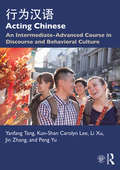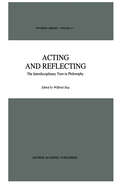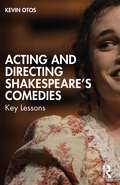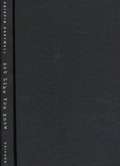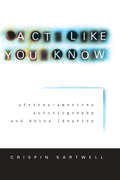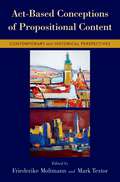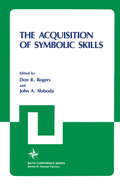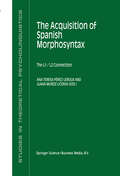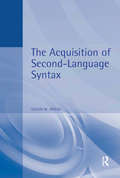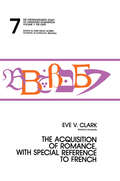- Table View
- List View
Acting Chinese: An Intermediate-Advanced Course in Discourse and Behavioral Culture 行为汉语
by Jin Zhang Li Xu Peng Yu Yanfang Tang Kunshan Carolyn LeeActing Chinese is a year-long course that, together with the companion website, integrates language learning with the acquisition of cultural knowledge, and treats culture as an integral part of human behavior and communication. Using modern day examples of Chinese discourse and behavioral culture, it trains students to perform in culturally appropriate fashion, whilst developing a systematic awareness and knowledge about Chinese philosophy, values and belief systems that will prepare them for further advanced study of Chinese language and culture. Each lesson contains simulated real-life communication scenarios that aim to provide a concrete opportunity to see how native speakers generally communicate or behave in social situations. An essential guide for intermediate to advanced level second language learners, Acting Chinese provides a unique and modern approach to the acquisition of both cultural knowledge and language proficiency.
Acting and Reflecting: The Interdisciplinary Turn in Philosophy (Synthese Library #211)
by Wilfried SiegActing and Directing Shakespeare's Comedies: Key Lessons
by Kevin OtosActing and Directing Shakespeare’s Comedies: Key Lessons outlines a clear, effective process for acting Shakespeare’s comedies. This book lays out core principles and useful exercises that help the reader better understand, expereince, and implement Shakespeare's comedic design. Building off of modern acting methods as well as contemporary Clown, classical Commedia, and verse-speaking techniques, the author guides the reader toward interpretive and performance choices that are original, justified, and entertaining. Included are clear examples and detailed case studies that illuminate and reenforce these key lessons. This accessible book is for actors, directors, students of Shakespeare, and those who want a fuller, richer awareness of the possibilities within Shakespeare’s comedies and a clear, pragmatic process for creating those performances.
Acting and Directing Shakespeare's Comedies: Key Lessons
by Kevin OtosActing and Directing Shakespeare’s Comedies: Key Lessons outlines a clear, effective process for acting Shakespeare’s comedies. This book lays out core principles and useful exercises that help the reader better understand, expereince, and implement Shakespeare's comedic design. Building off of modern acting methods as well as contemporary Clown, classical Commedia, and verse-speaking techniques, the author guides the reader toward interpretive and performance choices that are original, justified, and entertaining. Included are clear examples and detailed case studies that illuminate and reenforce these key lessons. This accessible book is for actors, directors, students of Shakespeare, and those who want a fuller, richer awareness of the possibilities within Shakespeare’s comedies and a clear, pragmatic process for creating those performances.
Act Like You Know (PDF): African-american Autobiography And White Identity
by Crispin SartwellFrederick Douglass, Harriet Jacobs, W.E.B. DuBois, Zora Neale Hurston, Malcolm X—their words speak firmly, eloquently, personally of the impact of white America on the lives of African-Americans. Black autobiographical discourses, from the earliest slave narratives to the most contemporary urban raps, have each in their own way gauged and confronted the character of white society. For Crispin Sartwell, as philosopher, cultural critic, and white male, these texts, through their exacting insights and external perspective, provide a rare opportunity, a means of glimpsing and gaining access to contents and core of white identity
Act Like You Know: African-American Autobiography and White Identity
by Crispin SartwellFrederick Douglass, Harriet Jacobs, W.E.B. DuBois, Zora Neale Hurston, Malcolm X—their words speak firmly, eloquently, personally of the impact of white America on the lives of African-Americans. Black autobiographical discourses, from the earliest slave narratives to the most contemporary urban raps, have each in their own way gauged and confronted the character of white society. For Crispin Sartwell, as philosopher, cultural critic, and white male, these texts, through their exacting insights and external perspective, provide a rare opportunity, a means of glimpsing and gaining access to contents and core of white identity. There is, Sartwell contends, a fundamental elusiveness to that identity. Whiteness defines itself as normative, as a neutral form of the human condition, marking all other forms of identity as "racial" or "ethnic" deviations. Invisible to itself, white identity seeks to define its essence over and against those other identities, in effect defining itself through opposition and oppression. By maintaining fictions of black licentiousness, violence, and corruption, white identity is able to cast itself as humane, benevolent, and pure; the stereotype fabricates not only the oppressed but the oppressor as well. Sartwell argues that African-American autobiography perceives white identity from a particular and unique vantage point; one that is knowledgeable and intimate, yet fundamentally removed from the white world and thus unencumbered by its obfuscating claims to normativity. Throughout this provocative work, Sartwell steadfastly recognizes the many ways in which he too is implicated in the formulation and perpetuation of racial attitudes and discourse. In Act Like You Know, he challenges both himself and others to take a long, hard look in the mirror of African-American autobiography, and to find there, in the light of those narratives, the visible features of white identity.
Act-Based Conceptions of Propositional Content: Contemporary and Historical Perspectives
by Friederike Moltmann and Mark TextorThe notion of a propositional content plays a central role in contemporary philosophy of language. Propositional content makes up both the meaning of sentences and the content of propositional attitudes such as belief. One particular view about propositional content has been dominant in analytic philosophy, namely the Fregean conception of propositions as abstract mind-independent objects that come with truth conditions. But propositions in this sense raise a range of issues, which have become a center of debate in current philosophy of language. In particular, how should propositions as abstract objects be understood and how can they represent things and be true or false? A number of philosophers in contemporary analytic philosophy as well as in early analytic philosophy and phenomenology have approached the notion of a propositional content in a different way, not by starting out with an abstract truth berarer, but by focusing on cognitive acts of agents, such as acts of judging. It is in terms of such acts that the notion of a propositional content, on their view, should be understood. The act-based perspective historically goes back to the work of Central European philosophers, in particular that of Husserl, Twardowski, Meinong, and Reinach. However, their work has been unduly neglected and is in fact largely inaccessible to contemporary analytic philosophers. The volume presents a central selection of work of these philosophers that bear on an act-based conception of philosophical content, some of which in new translations (one paper by Reinach), some of which published in English for the very first time (two papers by Twardowski). In addition, the volume presents new work by leading contemporary philosophers of language pursuing or discussing an act-based conception of propositional content. Moreover, the book contains a crosslinguistic study of nominalizations for actions and products, a distinction that plays a central role in the philosophy of language of Twardowski.
Act-Based Conceptions of Propositional Content: Contemporary and Historical Perspectives
The notion of a propositional content plays a central role in contemporary philosophy of language. Propositional content makes up both the meaning of sentences and the content of propositional attitudes such as belief. One particular view about propositional content has been dominant in analytic philosophy, namely the Fregean conception of propositions as abstract mind-independent objects that come with truth conditions. But propositions in this sense raise a range of issues, which have become a center of debate in current philosophy of language. In particular, how should propositions as abstract objects be understood and how can they represent things and be true or false? A number of philosophers in contemporary analytic philosophy as well as in early analytic philosophy and phenomenology have approached the notion of a propositional content in a different way, not by starting out with an abstract truth berarer, but by focusing on cognitive acts of agents, such as acts of judging. It is in terms of such acts that the notion of a propositional content, on their view, should be understood. The act-based perspective historically goes back to the work of Central European philosophers, in particular that of Husserl, Twardowski, Meinong, and Reinach. However, their work has been unduly neglected and is in fact largely inaccessible to contemporary analytic philosophers. The volume presents a central selection of work of these philosophers that bear on an act-based conception of philosophical content, some of which in new translations (one paper by Reinach), some of which published in English for the very first time (two papers by Twardowski). In addition, the volume presents new work by leading contemporary philosophers of language pursuing or discussing an act-based conception of propositional content. Moreover, the book contains a crosslinguistic study of nominalizations for actions and products, a distinction that plays a central role in the philosophy of language of Twardowski.
Across the Hellespont: A Literary Guide to Turkey
by Richard StonemanTurkey lies at the crossroads of history. For millennia, Anatolia has been crossed and re-crossed by waves of conquering civilizations - Hittites, Persians, Romans and Ottomans - who have created a country as varied as it is possible to find in the world. With a climate and landscape as diverse as its past, Turkey has provided an alluring and yet sometimes challenging destination for westerners throughout the ages. This, and the hospitality of its people has ensured that countless visitors, from classical times to the present, have fallen under the spell of Turkey.'Across the Hellespont' describes in lively detail the remarkable literature which Turkey has inspired for two thousand years. At a time when Turkey's position on the fringe may be set to change to a deeper involvement in Europe, the need for Europeans to understand the country is even more compelling. The range of travel writing represented in this book shows how, while political circumstances may change, the lure of Turkey remains constant.
Across Meridians: History and Figuration in Karen Tei Yamashita’s Transnational Novels (Asian America #74)
by Jinqi LingOver the course of the last two decades, novelist Karen Tei Yamashita has reshaped the Asian American literary imagination in profound ways. In Across Meridians, Jinqi Ling offers readers the most critically engaged examination to date of Yamashita's literary corpus. Crafted at the intersection of intellectual history, ethnic studies, literary analysis, and critical theory, Ling's study goes beyond textual investigation to intervene in larger debates over postmodern representation, spatial materialism, historical form, and social and academic activism. Arguing that Yamashita's most important contribution is her incorporation of a North-South vector into the East-West conceptual paradigm, Ling highlights the novelist's re-prioritization, through such a geographical realignment, of socio-economic concerns for Asian American literary criticism. In assessing Yamashita's works as such, Ling designates her novelistic art as a form of new Asian American literary avant-garde that operates from the peripheries of received histories, aesthetics, and disciplines. Seeking not only to demonstrate the importance of Yamashita's transnational art, Ling sets new terms for ongoing dialogues in Asian American literary and cultural criticism. At the same time, he argues for the continuing relevance of Asian American literature as a self-reflexive and self-renewable critical practice.
Across an Inland Sea: Writing in Place from Buffalo to Berlin
by Nicholas HoweHow do the places we live in and visit shape our lives and memories? What does it mean to reside in different locations across the span of a life? In richly textured portraits of places seen from within, Nicholas Howe contemplates how places create and gather their stories and how, in turn, a sense of place locates the stories of our own lives. Howe begins with one of the finest descriptions ever written of Buffalo, that city on an inland sea where he grew up. He gives us a fresh Paris, viewed from the river below. And he depicts Oklahoma as a site of open lands and dislocation--a place of coming and going. Howe then turns to Chartres, a traditional location of pilgrimage, to ask what other sites might still be capable of compelling visitors in secular time. He portrays Berlin as a scene of twentieth-century history--and a city that helped him make sense of his American life. Finally, he writes about Columbus, Ohio, as home. Vividly rendering the places he has known, Howe meditates on the weight of home, the temptations of the metropolis, the fact of dislocation, the unraveling of history, the desire to remake ourselves through voyage, and the wonder of the familiar. In ways that too often elude travel writers, it is place that holds our imagination, that inspires much of our art and literature. Across an Inland Sea evokes the various senses of place that can fill and haunt a life--and ultimately give life its form and meaning.
Across an Inland Sea: Writing in Place from Buffalo to Berlin
by Nicholas HoweHow do the places we live in and visit shape our lives and memories? What does it mean to reside in different locations across the span of a life? In richly textured portraits of places seen from within, Nicholas Howe contemplates how places create and gather their stories and how, in turn, a sense of place locates the stories of our own lives. Howe begins with one of the finest descriptions ever written of Buffalo, that city on an inland sea where he grew up. He gives us a fresh Paris, viewed from the river below. And he depicts Oklahoma as a site of open lands and dislocation--a place of coming and going. Howe then turns to Chartres, a traditional location of pilgrimage, to ask what other sites might still be capable of compelling visitors in secular time. He portrays Berlin as a scene of twentieth-century history--and a city that helped him make sense of his American life. Finally, he writes about Columbus, Ohio, as home. Vividly rendering the places he has known, Howe meditates on the weight of home, the temptations of the metropolis, the fact of dislocation, the unraveling of history, the desire to remake ourselves through voyage, and the wonder of the familiar. In ways that too often elude travel writers, it is place that holds our imagination, that inspires much of our art and literature. Across an Inland Sea evokes the various senses of place that can fill and haunt a life--and ultimately give life its form and meaning.
Across an Inland Sea: Writing in Place from Buffalo to Berlin
by Nicholas HoweHow do the places we live in and visit shape our lives and memories? What does it mean to reside in different locations across the span of a life? In richly textured portraits of places seen from within, Nicholas Howe contemplates how places create and gather their stories and how, in turn, a sense of place locates the stories of our own lives. Howe begins with one of the finest descriptions ever written of Buffalo, that city on an inland sea where he grew up. He gives us a fresh Paris, viewed from the river below. And he depicts Oklahoma as a site of open lands and dislocation--a place of coming and going. Howe then turns to Chartres, a traditional location of pilgrimage, to ask what other sites might still be capable of compelling visitors in secular time. He portrays Berlin as a scene of twentieth-century history--and a city that helped him make sense of his American life. Finally, he writes about Columbus, Ohio, as home. Vividly rendering the places he has known, Howe meditates on the weight of home, the temptations of the metropolis, the fact of dislocation, the unraveling of history, the desire to remake ourselves through voyage, and the wonder of the familiar. In ways that too often elude travel writers, it is place that holds our imagination, that inspires much of our art and literature. Across an Inland Sea evokes the various senses of place that can fill and haunt a life--and ultimately give life its form and meaning.
The Acquisition of Verbs and their Grammar: The Effect of Particular Languages (Studies in Theoretical Psycholinguistics #33)
by Natalia Gagarina Insa GülzowThis volume investigates the linguistic development of children with regard to their knowledge of the verb and its grammar. The selection of papers brings to researchers and in particular psycholinguists empirical evidence from a wide variety of languages from Hebrew, through English to Estonian. The authors interpret their findings with a focus on cross-linguistic similarities and differences, without subscribing to either a UG-based or usage-based approach.
The Acquisition of Verb Placement: Functional Categories and V2 Phenomena in Language Acquisition (Studies in Theoretical Psycholinguistics #16)
by Jurgen M. Meiselother aspects of developing grammars. And this is, indeed, what the contributions to this volume do. Parameterization of functional categories may, however, be understood in different ways, even if one shares the dual assumptions that substantive elements (verbs, nouns, etc. ) are present in all grammars and that X-bar principles are part of the grammatical knowledge available to the child prior to language-specific learning processes. From these assumptions it follows that the child should, from early on, be able to construct projections on the basis of these elements. The role of functional categories, however, may still be interpreted differently. One possibility, first suggested by Radford (1986, 1990) and by Guilfoyle and Noonan (1988), is that children must discover which functional categories (FC) need to be implemented in the grammar of the language they are acquiring. Another possibility, first explored by Hyams (1986), is that a specific category is present in developing grammars but that parameter values are set in a way deviating from the target adult grammar, corresponding, however, to options realized in other adult systems. A third option would be that these categories might be specified differently in developing as opposed to mature grammars. All three are explored in the papers collected in this volume. Before outlining the various hypotheses in more detail, however, I would like briefly to sketch the grammatical context in which the following debate is situated. 2.
The Acquisition of Syntax: Studies in Comparative Developmental Linguistics (Longman Linguistics Library)
by Marc-Ariel Friedemann Luigi RizziThis volume contains a collection of studies that survey recent research in developmental linguistics, illustrating the fruitful interaction between comparative syntax and language acquisition. The contributors each analyse a well defined range of acquisition data, aiming to derive them from primitive differences between child and adult grammar. The book covers cross-linguistic and cross-categorial phenomena, shedding light on major developments in this novel and rapidly growing field. Extensions to second language acquisition and neuropathology are also suggested.
The Acquisition of Syntax: Studies in Comparative Developmental Linguistics (Longman Linguistics Library)
by Marc-Ariel Friedemann Luigi RizziThis volume contains a collection of studies that survey recent research in developmental linguistics, illustrating the fruitful interaction between comparative syntax and language acquisition. The contributors each analyse a well defined range of acquisition data, aiming to derive them from primitive differences between child and adult grammar. The book covers cross-linguistic and cross-categorial phenomena, shedding light on major developments in this novel and rapidly growing field. Extensions to second language acquisition and neuropathology are also suggested.
The Acquisition of Symbolic Skills (Nato Conference Series #22)
by Don Rogers John A. SlobodaThis book is a selection of papers from a conference which took place at the University of Keele in July 1982. The conference was an extraordinarily enjoyable one, and we would like to take this opportunity of thanking all participants for helping to make it so. The conference was intended to allow scholars working on different aspects of symbolic behaviour to compare findings, to look for common ground, and to identify differences between the various areas. We hope that it was successful in these aims: the assiduous reader may judge for himself. Several themes emerged during the course of the conference. Some of these were: 1. There is a distinction to be made between those symbol systems which attempt, more or less directly, to represent a state of affairs in the world (e. g. language, drawing, map and navigational skill) and those in which the representational function is complemented, if not overshadowed, by properties of the symbol system itself, and the systematic inter-relations that symbols can have to one another (e. g. music, mathematics). The distinction is not absolute, for the nature of all symbolic skills is, in part, a function of the structure of the symbolic system employed. Nonetheless, this distinction helps us to understand some common acquisition difficulties, such as that experienced in mathematics, where mental manipulation of symbols can go awry if a child assumes too close a correspondence between mathematical symbols and the world they represent. 2.
The Acquisition of Spanish Morphosyntax: The L1/L2 Connection (Studies in Theoretical Psycholinguistics #31)
by Juana MuñozLiceras Ana TeresaPérez-LerouxRecent developments in linguistic theory, as well as the growing body of evidence from languages other than English, provide new opportunities for deeper explorations into how language is represented in the mind of learners. This collection of new empirical studies on the acquisition of Spanish morphosyntax by leading researchers in the field of language acquisition, specifically contributes to the characterization of the L1 / L2 connection in acquisition. Using L1 and L2 Spanish data from children and adults, the authors seek to address the central questions that have occupied developmental psycholinguists in the final decades of the previous century and that will no doubt continue engaging them into the present one.
The Acquisition of Spanish as a Second Language: Foundations and New Developments
by Kimberly L. Geeslin Avizia Y. Long Megan SolonThis volume offers an introduction to the field of second language acquisition with a particular focus on second language Spanish. It connects key issues in the acquisition of Spanish as a second language to theoretical and empirical issues in the field of second language acquisition more generally by exemplifying central concepts in second language acquisition through the exploration of the most widely researched structures and most recent developments in the field of second language Spanish. It is written for a non-specialist audience, making it suitable for advanced undergraduate and graduate courses and readers, while its treatment of recent empirical developments also makes it of interest to researchers in second language Spanish as well as allied fields.
The Acquisition of Spanish as a Second Language: Foundations and New Developments
by Kimberly L. Geeslin Avizia Y. Long Megan SolonThis volume offers an introduction to the field of second language acquisition with a particular focus on second language Spanish. It connects key issues in the acquisition of Spanish as a second language to theoretical and empirical issues in the field of second language acquisition more generally by exemplifying central concepts in second language acquisition through the exploration of the most widely researched structures and most recent developments in the field of second language Spanish. It is written for a non-specialist audience, making it suitable for advanced undergraduate and graduate courses and readers, while its treatment of recent empirical developments also makes it of interest to researchers in second language Spanish as well as allied fields.
Acquisition of Second Language Syntax
by Susan BraidiThis book deals with the questions asked about the L2 acquisition process within different research paradigms, examines the results found in each approach, and evaluates the contributions of each to our understanding of L2 acquisition of syntax and to possible implications for L2 instruction.
Acquisition of Second Language Syntax
by Susan BraidiThis book deals with the questions asked about the L2 acquisition process within different research paradigms, examines the results found in each approach, and evaluates the contributions of each to our understanding of L2 acquisition of syntax and to possible implications for L2 instruction.
The Acquisition of Scrambling and Cliticization (Studies in Theoretical Psycholinguistics #26)
by Susan M. Powers Cornelia HamannThis collection of papers investigates two specific linguistic phenomena from the point of view of first- and second-language acquisition. While observations on the acquisition of scrambling or pronominal clitics can be found in the literature, up until the recent past they were sparse and often buried in other issues. This volume fills a long-existing gap in providing a collection of articles which focus on language acquisition but at the same time address the overarching syntactic issues involved (for example, the X-bar status of clitics, base-generation vs. movement accounts of scrambling). This volume contains an overview of L1 (and, in one case, L2) acquisition data from a number of different languages including Bernese, Swiss, German, Dutch, English, French, German, Italian, Spanish and Swedish, as well as from several theoretical points of view with these two clause-internal processes at its center. These language acquisition data are considered to be crucial in the validation of analyses of these specific linguistic phenomena in adult grammars. The contributions in this volume include the earliest thoughts in this vein and, for this reason, should be viewed as a starting point for discussions within theoretical linguistics and language acquisition alike.
The Acquisition of Romance, With Special Reference To French: The Crosslinguistic Study of Language Acquisition, Volume 1, Chapter 7
by Eve ClarkFirst published in 1986. This edition offers a grammatical sketch of French, with occasional comments on how other Romance languages diverge from this picture; a brief account of the sources available on language acquisition by children; and a summary of the overall course of development in children acquiring the major Romance languages. The remainder of the review takes up different facets of the language acquisition process in more detail.
